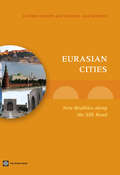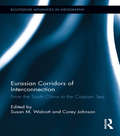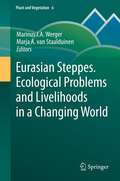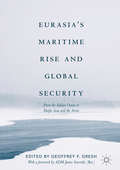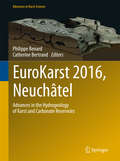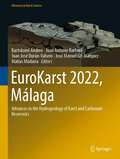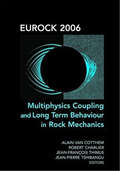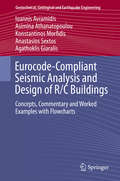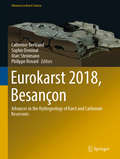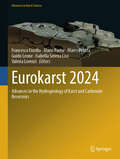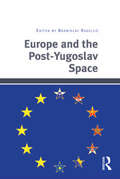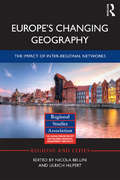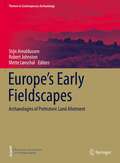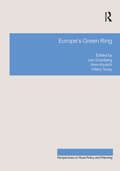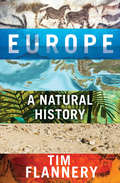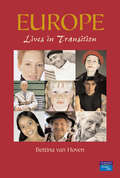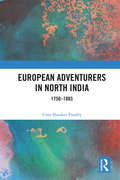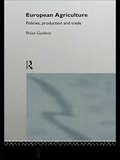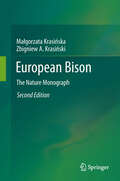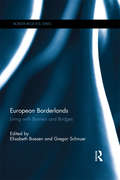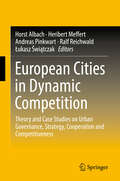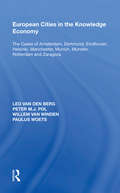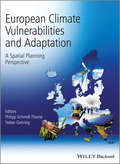- Table View
- List View
Eurasian Business and Economics Perspectives: Proceedings of the 47th Eurasia Business and Economics Society Conference (Eurasian Studies in Business and Economics #34)
by Mehmet Huseyin Bilgin Hakan Danis Ender Demir Manuela ZipperlingThis proceedings book is the 34th issue of the Springer&’s series Eurasian Studies in Business and Economics, which is the official book series of the Eurasia Business and Economics Society. This book includes selected papers presented at the 47th EBES Conference—Berlin—on April 18–20, 2024, hosted by FOM University of Applied Sciences, Berlin, Germany. In the conference, 229 papers by 458 colleagues from 52 countries were presented. The conference was held hybrid with both, in-person and online paper presentation formats.
Eurasian Cities: New Realities along the Silk Road
by Charles Kunaka Souleymane Coulibaly Uwe Deichmann William R. Dillinger Marcel Ionescu-Heroiu Ioannis N. Kessides Daniel SaslavskyThis report responds to pressing questions for policymakers in Eurasian cities and national governments. Faced with changing economic circumstances and a reorientation of trade toward Europe and Asia, will Eurasia's cities be able to adjust? Will some cities be granted the flexible regulations and supportive policies necessary for growth? And will some be permitted to shrink and their people assisted in finding prosperity elsewhere in the region?Even as Eurasian cities diverge, they face shared challenges. Policymakers have a key role in assisting spatial restructuring, particularly in addressing imperfect information and coordination failures. They can do so by rethinking cities, better planning them, better connecting them, greening them and finding new ways to finance these changes. Eurasian cities will also have to find the right balance between markets and institutions to become sustainable. As the World Development Report 2009: Reshaping Economic Geography illustrates, Eurasia (excluding Russia) is a 3D region- a region with low density, long distance, and many divisions. Securing accessibility to leading regional markets such as China, India, and Russia is thus critical. This will require key institutions to be developed to unite the countries, key connective infrastructures to be established between domestic and regional markets, and targeted interventions to be undertaken to compensate countries for short-term losses from this deepened economic integration. Policymakers at the highest levels in these countries should put accessibility at the top of their agendas.
Eurasian Corridors of Interconnection: From the South China to the Caspian Sea (Routledge Advances in Geography #10)
by Corey Johnson Susan M. WalcottConnectivity, as well as conflict, characterizes Eurasia. This edited volume explores dynamic geopolitical and geo-economic links reconfiguring spaces from the eastern edge of Europe through the western edge of Asia, seeking explanation beyond description. The ancient Silk Road tied together space, much as pipelines, railroads, telecommunications infrastructure, and similar cultural and constructed links ease the mobility of people and products in modern Eurasia. This book considers Eurasia along an interlinked corridor, with chapters illustrating the connections as a discussion foundation focusing on the shared interactions of a set of nation states through time and across space, generating more positive considerations of the resurgently important region of Eurasia. China’s interests fall into three chapters: the southeastern border with Vietnam, the southwestern Himalayan edge, and the western Muslim regions. Russia’s recovery relates events to a larger landmass context and focuses on the importance of historic mobility. A geo-history of the Caspian considers this petroleum-rich area as a zone of cultural and economic interconnection. The final focus on Central Asia treats the traditional heart of “Eurasia”. The concluding chapter pulls together strands linking subregions for a new concept of “Eurasia” as an area linked by vital interests and overlapping histories.
Eurasian Steppes. Ecological Problems and Livelihoods in a Changing World
by Marinus J.A. Werger Marja A. van StaalduinenSteppes form one of the largest biomes. Drastic changes in steppe ecology, land use and livelihoods came with the emergence, and again with the collapse, of communist states. Excessive ploughing and vast influx of people into the steppe zone led to a strong decline in nomadic pastoralism in the Soviet Union and China and in severely degraded steppe ecosystems. In Mongolia nomadic pastoralism persisted, but steppes degraded because of strongly increased livestock loads. After the Soviet collapse steppes regenerated on huge tracts of fallow land. Presently, new, restorative steppe land management schemes are applied. On top of all these changes come strong effects of climate change in the northern part of the steppe zone. This book gives an up-to-date overview of changes in ecology, climate and use of the entire Eurasian steppe area and their effects on livelihoods of steppe people. It integrates knowledge that so far was available only in a spectrum of locally used languages.
Eurasia’s Maritime Rise and Global Security: From The Indian Ocean To Pacific Asia And The Arctic (Palgrave Studies in Maritime Politics and Security)
by Geoffrey F. GreshThis book explores Eurasia’s growing embrace of its maritime geography from the Indian Ocean to Pacific Asia and the Arctic. In an age of climate change, the melting of the Arctic will transform Eurasia’s importance, in addition to influencing the political, economic, and military dynamics across Eurasia’s main maritime regions. These emerging shifts have already begun to alter maritime trade and investment patterns, and thus the global political economy. It also creates a rising threat to the current status quo of world order that has long been dominated by the Atlantic World. This edited volume showcases some of the world’s leading experts and examines Eurasia from a saltwater perspective, analyzing its main maritime spaces in a threefold manner—as avenue, as arena, as source—to show the significance of this geostrategic change and why it matters for the future of the world’s oceans.
EuroKarst 2016, Neuchâtel
by Catherine Bertrand Philippe RenardThis book presents the latest advances in the field of karst hydrogeology and carbonate reservoirs. These include, but are not limited to: geomorphology of karst, flow and solute transport in karst; innovative metrology; modelling; speleogenesis and geology of carbonate reservoirs; deep reservoir exploration and production; water management and protection in karst environments; contaminant migration and chemical behavior; hydrochemistry and regional aquifer studies. EuroKarst offers a platform for professional exchanges between field practitioners and academic researchers. It is the European biennial conference on the hydrogeology of karst and carbonate reservoirs. It is organized every two years by the Universities of Neuchâtel (Switzerland), Besançon (France), and Malaga (Spain).
EuroKarst 2022, Málaga: Advances in the Hydrogeology of Karst and Carbonate Reservoirs (Advances in Karst Science)
by Bartolomé Andreo Juan Antonio Barberá Juan José Durán-Valsero José Manuel Gil-Márquez Matías MudarraThis book covers advances in the field of karst from a variety of perspectives to facilitate knowledge and promote interaction between disciplines. New methods are addressed that advance data collection, analysis, and interpretation in a wide range of karst contexts. Case studies are presented to provide examples of advancing science. Issues addressed include karst hydrogeology (water resources assessment, groundwater pollution and protection), methods to study karst aquifers (based on hydrodynamic, hydrochemistry, isotopes, dye tracing, geophysical surveys, and modeling techniques), karst geomorphology and landscape, mining and engineering in karst media (tunnels, dams, etc.), and karst cavities (touristic caves, natural heritage). This book is a resource for scientists around the world to compare problems, results, and solutions. Likewise, the examples included are used in policy decision making in karst regions. Finally, the contributions are used as a tool for university teaching.
Eurock 2006: Proceedings of the International Symposium of the International Society for Rock Mechanics, Eurock 2006, Liege, Belgium, 9-12 May 2006
by Jean-François Thimus Robert Charlier Alain Van Cotthem Jean-Pierre TshibanguSpecial emphasis is given to the constitutive behaviour of rock material, including rock mechanics and partial saturation, chemo-mechanics, thermo-hydro-mechanics, weathering and creep. Theoretical concepts, laboratory and field experiments and numerical simulations are discussed. Multiphysics coupling and long-term behaviour has practical applicat
Eurocode-Compliant Seismic Analysis and Design of R/C Buildings
by Ioannis Avramidis Asimina Athanatopoulou Konstantinos Morfidis Anastasios Sextos Agathoklis GiaralisThis book aims to serve as an essential reference to facilitate civil engineers involved in the design of new conventional (ordinary) reinforced concrete (R/C) buildings regulated by the current European EC8 (EN 1998-1:2004) and EC2 (EN 1992-1-1:2004) codes of practice. The book provides unique step-by-step flowcharts which take the reader through all the required operations, calculations, and verification checks prescribed by the EC8 provisions. These flowcharts are complemented by comprehensive discussions and practical explanatory comments on critical aspects of the EC8 code-regulated procedure for the earthquake resistant design of R/C buildings. Further, detailed analysis and design examples of typical multi-storey three-dimensional R/C buildings are included to illustrate the required steps for achieving designs of real-life structures which comply with the current EC8 provisions. These examples can be readily used as verification tutorials to check the reliability of custom-made computer programs and of commercial Finite Element software developed/used for the design of earthquake resistant R/C buildings complying with the EC8 (EN 1998-1:2004) code. Th is book will be of interest to practitioners working in consulting and designing engineering companies and to advanced undergraduate and postgraduate level civil engineering students attending cours es and curricula in the earthquake resistant design of structures and/or undertaking pertinent design projects.
Eurokarst 2018, Besançon: Advances in the Hydrogeology of Karst and Carbonate Reservoirs (Advances in Karst Science)
by Catherine Bertrand Philippe Renard Sophie Denimal Marc SteinmannThis book presents selected papers from the EuroKarst 2018 conference, which highlighted the latest advances in the field of Karst Hydrogeology and Carbonate Reservoirs. The event attracted more than 180 participants. From among their contributions, the papers were selected and subsequently reviewed by the scientific committee to ensure the highest possible quality.
Eurokarst 2024: Advances in the Hydrogeology of Karst and Carbonate Reservoirs (Advances in Karst Science)
by Mario Parise Francesco Fiorillo Marco Petitta Guido Leone Isabella Serena Liso Valeria LorenziThis book covers advances in the field of karst from a variety of perspectives to facilitate knowledge and promotes interaction between disciplines. New methods are addressed that advance data collection, analysis, and interpretation in a wide range of karst contexts. Case studies are presented to provide examples of advancing science. Issues addressed include karst hydrogeology (water resources assessment, groundwater pollution and protection), methods to study karst aquifers (based on hydrodynamic, hydrochemistry, isotopes, dye tracing, geophysical surveys, and modelling techniques), karst geomorphology and landscape, mining and engineering in karst media (tunnels, dams, etc.), and karst cavities (touristic caves, natural heritage). This book is a resource for scientists around the world to compare problems, results and solutions. Likewise, the examples included can be used in policy decision making in karst regions. Finally, the contributions can be used as a tool for university teaching.
Europe and the Post-Yugoslav Space
by Branislav RadeljićCharting the path from intervention to integration Europe and the Post-Yugoslav Space examines the role of Europeanization on the development of the countries of the former Yugoslavia. Slovenia, Croatia, Macedonia, Montenegro, Serbia, Bosnia and Herzegovina and Kosovo may have a shared history but their experiences, views and attitudes to European integration vary dramatically. Opinion within each state is often equally as keenly divided as to the benefits of active membership. The debate within each country and their comparative differences in approach provide fascinating case studies on the importance and relevance of the EU and the effectiveness of Europeanization. A wide range of contributors with significant experience gained within the EU as well as their country of origin use their expert understanding of the language and cultures of the countries concerned to provide detailed and rich insights into the troubled history and potential of the post-Yugoslav space.
Europe's Changing Geography: The Impact of Inter-regional Networks (Regions and Cities #65)
by Nicola Bellini Ulrich HilpertEuropean macro-regions, Euroregions and other forms of inter-regional, cross-border cooperation have helped to shape new scenarios and new relational spaces which may generate opportunities for economic development, while redefining the political and economic meaning of national borders. This book is based on a number of key case studies which are crucial to understanding the complex web of political, economic and cultural factors that shape the heterogeneous picture of Europe’s new geography. This book provides a fresh view on this phenomenon, with a realistic approach shedding light on its complexity as well as on its ambiguities. The new macro-regions are interpreted with an approach recognizing the importance of institutionalization, but also their flexible configuration and "blurred" borders. The book also raises the issue of credibility and legitimacy, arguing that inter-regional cooperation has to be removed from the foggy realm of the exchanges between local political and bureaucratic elites in order to be clearly and concretely motivated, and functional to key strategic objectives of the regions. Finally, the authors suggest a complementarity between relations based on proximity and wider (possibly global) networks where some territories, and especially metropolises, find opportunities based on "virtual" proximity. Europe's Changing Geography provides a substantial re-appraisal of a key phenomenon in the process of European integration today. It will be of interest both to scholars of the political economy of European regionalism and to practitioners.
Europe's Early Fieldscapes: Archaeologies of Prehistoric Land Allotment (Themes in Contemporary Archaeology)
by Robert Johnston Stijn Arnoldussen Mette LøvschalThis volume focuses on the development of field systems through time and space and in their wider landscape context, including classical issues pertaining to past land use and management regimes, including manuring, water, land and crop management, and technologies such as slash‐and‐burn cultivation, and use of the ard and plough. This book provides the first comprehensive attempt to bring together and provide a comprehensive insight into the latest prehistoric fieldscape research across Europe. The book raises a broader awareness of some of the main questions and scientific requests that are addressed by scholars working in various fieldscapes across Europe. Themes addressed in this book include (a) mapping and understanding field system morphologies at various scales, (b) the extraction of information on social processes from field system morphologies, (c) the relations between field systems and cultural and natural features of their environment, (d) time-depths and temporalities of usage, and (e) specifics of the underlying agricultural systems, with special attention to matters of continuity and resilience and relation to changing practices. The case-studies explore how to best approach such landscapes with traditional and novel methodologies and targeted research in order to enhance our knowledge further. The volume offers inspiration and guidance for the heritage management of fieldscape heritage – not solely for future scholarly research but foremost to stimulate strategic guidance to frame and support improved protection of evidently vulnerable resources for Europe’s future. This volume is of interest to landscape archaeologists.
Europe's Green Ring (Perspectives on Rural Policy and Planning)
by Leo Granberg Imre KováchAround the fringe of Europe lies a green ring of countries which have followed different pathways into modernity from the industrial core of the continent and have, until recently, been characterized by a strong agrarian presence in their politics, economy and culture. This book brings together case studies from both the post-socialist countries and EU member states which make up the green ring to compare experiences of rural and agricultural groups. It provides a fascinating opportunity to identify similarities and contrasts in the ways in which these countries have managed their rural areas when faced with the challenges set by industrialization, political integration and globalization. The book focuses on agrarian transformation as de- (and sometimes re- ) peasantization - referring to the changing economic, social, cultural and political positions of farmers and food production workers. It also problematizes the standard rural models and opens up discussion of the problems these models pose for the farmers of the green ring countries.
Europe: A Natural History
by Tim FlanneryA tale of cave bears and comet strikes and a hundred million years of history by the bestselling author of Here on Earth: &“Marvelous.&”—Publishers Weekly (starred review) In Europe: A Natural History, world-renowned scientist, explorer, and conservationist Tim Flannery applies the eloquent interdisciplinary approach he used in his ecological histories of Australia and North America to the story of Europe. He begins 100 million years ago, when the continents of Asia, North America, and Africa interacted to create an island archipelago that would later become the Europe we know today. It was on these ancient tropical lands that the first distinctly European organisms evolved. Flannery teaches us about Europe&’s midwife toad, which has endured since the continent&’s beginning, while elephants, crocodiles, and giant sharks have come and gone. He explores the monumental changes wrought by the devastating comet strike and shows how rapid atmospheric shifts transformed the European archipelago into a single landmass during the Eocene. As the story moves through millions of years of evolutionary history, Flannery eventually turns to our own species, describing the immense impact humans had on the continent&’s flora and fauna—within 30,000 years of our arrival in Europe, the woolly rhino, the cave bear, and the giant elk, among others, would disappear completely. The story continues right up to the present, as Flannery describes Europe&’s leading role in wildlife restoration, and then looks ahead to ponder the continent&’s future: with advancements in gene editing technology, European scientists are working to recreate some of the continent&’s lost creatures, such as the great ox of Europe&’s primeval forests and even the woolly mammoth.
Europe: Lives in Transition
by Tim Unwin Bettina Van HovenFirst published in 2003. Routledge is an imprint of Taylor & Francis, an informa company.
European Adventurers in North India: 1750–1803
by Uma Shanker PandeyThis book explores how European, particularly French, adventurers shaped early modern India. It highlights the significant contributions of these adventurers in social, political, economic, and intellectual life of north India in the 18th and the 19th centuries. The author examines how the French adventurers played a key role in bringing Western science and ideas to a polity in flux. He examines the role of individuals like René Madec, Sombre, De Boigne, Perron, Gentil, Canaple, Delamarr, Sonson, and Pedrose, who made instrumental contributions in modernising armies of pre-modern states in South Asia. The volume also underlines how French adventurers’ commercial networks developing from their enterprises opened up markets in the heartlands of north India for European consumers. Further, it brings to the fore intellectual pursuits of the leading French figures such as Anquetil Duperron, Polier, Gentil, De Boigne, and Perron, whose engagement with Indian literature opened a new chapter framing studies of the Occident. Rich in French, English, and translated Persian archival resources, this book will be of interest to scholars and researchers of colonial history, early modern history, military history, and South Asian studies.
European Agriculture: Policies, Production and Trade
by Brian GardnerThe Common Agricultural Policy (CAP) is central to both economic and environmental developments in Europe. But with the advent of new environmental legislation and political change in Europe the CAP faces increasing pressure to reform. European Agriculture provides a comprehensive breakdown of the workings of the CAP and its impact on farming in Europe. The author discusses every aspect of European agricultural policy, production and trade, from environmental contraints and the impact of biotechnology, to the role of European farming in the world food supply system. Posing direct questions about the recent 1992 agricultural reform, the 1994 GATT agreement and the reasons for the expensive continuation of the CAP, European Agriculture analyses the economic, political and environmental implications of pursuing present farming policy and provides a provocative commentary on the agricultural future of Europe.
European Bison
by Małgorzata Krasińska Zbigniew A. KrasińskiThe mighty and majestic European bison is the relictual embodiment of the wildness of prehistoric Europe. Tragically, the millennia since that time have seen so many species driven to extinction by human impacts, and the European bison has only narrowly avoided the same fate. Today, the species represents the symbolic sentinel of successful conservation actions in a world in which such achievements remain few and far between. From an early stage in the restitution of the European bison, husband-and-wife team Małgorzata Krasińska and Zbigniew A. Krasiński have been participating in relevant management initiatives and researching all facets of the bison, from its morphology and diet, to its movements, social life and reproduction, and the conservation management actions that have been taken to save it. Now they have summarised this wealth of knowledge on the species, giving rise to a publication ideal for students, professional biologists and conservationists, but also for all nature enthusiasts. This new edition of the monograph offers extensively updated content taking into account research carried out on the European bison in the last few years. Also featured, a new chapter devoted to knowledge of the genetics of the species drawn up by Małgorzata Tokarska of the Białowieża-based Mammal Research Institute PAS.
European Borderlands: Living with Barriers and Bridges (Border Regions Series)
by Edited by Elisabeth Boesen and Gregor schnuerThe expectations of European planners for the gradual disappearance of national borders, and the corresponding prognoses of social scientists, have turned out to be over-optimistic. Borders have not disappeared – not even in a unified and predominantly peaceful Europe – but rather they have changed, become more varied and, in a certain sense, mobile, taking on an important role in the everyday lives of more people than ever before. Furthermore, it is now widely accepted that borders do not just hinder communication and the formation of relationships, but also channel and prefigure them in a positive way. Presenting a number of studies of everyday life in European borderlands, this book addresses the multifarious and complex ways in which borders function as both barriers and bridges. Focusing on ‘established’ Western European borderlands – with the exception of three contrasting cases – the book attempts a turn from conflict to harmony in the study of borderlands and thus examines the more mundane manifestations of border life and the complex, often unconscious motives of everyday cross-border practices. The collection of chapters demonstrates that even in the case of ‘open’ political borders, the border remains an enduring factor that is not adequately described as either a problematic barrier or a desirable bridge. The studies look at bordering processes, not only approaching them from different disciplinary angles – sociology, anthropology, geography, history, political science and literary studies – but also choosing different scales and making comparisons that range from different borders of one country to the reactions and attitudes of different individuals in a single borderland village.
European Cities in Dynamic Competition: Theory and Case Studies on Urban Governance, Strategy, Cooperation and Competitiveness
by Horst Albach Heribert Meffert Andreas Pinkwart Ralf Reichwald Łukasz ŚwiątczakWorld population and the number of city dwellers are steadily growing. Globalization and digitalization lead to an increased competition for skilled and creative labor and other economic resources. This is true not only for firms, but increasingly also for cities. The book elaborates on resulting challenges and opportunities for urban management from the European perspective, and discusses theories, methods and tools from business economics to cope with them. Contributions in this volume come from scholars and practitioners of economics, business administration and urban management, and cover aspects ranging from urban dynamics to city marketing. They draw on experiences from several European cities and regions, and discuss strategies to improve city performance including Open Government, Smart City, cooperation and innovation. The book project was initiated and carried out by the Center for Advanced Studies in Management (CASiM), the interdisciplinary research center of HHL Leipzig Graduate School of Management. It is addressed to scholars and managers in Europe and beyond, who will benefit from the scientific rigor and useful practical insights of the book.
European Cities in the Knowledge Economy: The Cases of Amsterdam, Dortmund, Eindhoven, Helsinki, Manchester, Munich, M�nster, Rotterdam and Zaragoza (Euricur Series (european Institute For Comparative Urban Research) Ser.)
by Leo van BergAcross Western Europe, the emphasis has shifted from physical manufacturing to the development of ideas, new products and creative processes. This has become known as the knowledge economy. While much has been written about this concept, so far there has been little focus on the role of the city. Bringing together comparative case studies from Amsterdam, Dortmund, Eindhoven, Helsinki, Manchester, Munich, Münster, Rotterdam and Zaragoza, this volume examines the cities' roles, as well as how the knowledge economy affects urban management and policies. In doing so, it demonstrates that the knowledge economy is a trend that affects every city, but in different ways depending on the specific local situation. It describes a number of policy options that can be applied to improve cities' positions in this new environment.
European Climate Vulnerabilities and Adaptation
by Philipp Schmidt-Thome Stefan GreivingEuropean Climate Vulnerabilities and Adaptation: A Spatial Planning Perspective analyses the impacts climate change might have on regions and their local economies. Regions clearly differ in view of the complex patterns of climate change impact, but also regarding the given vulnerability and coping capacity.Impacts of climate change can have a marked effect on the functioning of regions and sectors of the society, if not properly addressed. Readiness to adapt to the impacts and lasting changes counts towards vulnerability of the regions.The book builds upon the findings of a project conducted under the European observation network for territorial development and cohesion (ESPON), The ESPON Climate project. Following the stipulations of the ESPON programme and the tender for this project the territorial focus is the raison d'être and methodological core of the project as a whole and its various research actions: The outcomes of each action will be focused on what impacts global climate change will have for the different European regions and how the regions can cope with the projected impacts in order to become less vulnerable to climate change.This book: Provides a comprehensive analysis of climate change impacts on 29 European regions and their local economiesTakes an interdisciplinary approach dealing with the physical, social, economic, environmental, cultural and institutional aspects of climate change vulnerability and the consequences for spatial planningBuilds on the findings of the ESPON Climate project with a policy focused approachIs in full colour throughout with a broad range of case studies

